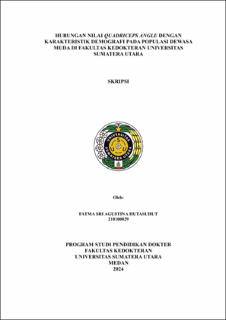Hubungan Nilai Quadriceps Angle dengan Karakteristik Demografi pada Populasi Dewasa Muda di Fakultas Kedokteran Universitas Sumatera Utara
The Relationship Between Quadriceps Angle Value and Demographic Characteristics in The Young Adult Population at The Faculty of Medicine, Universitas Sumatera Utara

Date
2024Author
Hutasuhut, Fatma Sri Agustina
Advisor(s)
Winanto, Iman Dwi
Metadata
Show full item recordAbstract
Background. Quadriceps angle or Q-angle is one of the indicators of patellofemoral joint dysfunction. The value of Q-angle is influenced by various factors, one of which is demographic characteristics. There is a 6-7% incidence of patellofemoral joint dysfunction in the young adult population of varying severity. The Q-angle can provide important information about the position of the knee joint thus can be an indicator of the biomechanical function of the lower extremities. Objective. To know the relationship between Q-angle values and demographic characteristics in the young adult population at the Faculty of Medicine, Universitas Sumatera Utara. Methode. This observational analytic study with cross-sectional approach was conducted on students of the Faculty of Medicine, Universitas Sumatera Utara. Data were obtained through measuring the Q-angle value using a goniometer and completion of the demographic characteristics questionnaire. After collecting samples with stratified random sampling technique, 97 samples were acquired. Data were analyzed with t-test comparative test, spearman and mann-whitney correlative test to determine the relationship between each variables. Result. There was a significant association between age p = <0,001, body mass index p = 0,009, and dominant leg p = 0,020 with Q-angle value. Conclusion. There is a significant relationship between age, body mass index, and dominant leg on Q-angle values in the young adult population at the Faculty of Medicine, Universitas Sumatera Utara.
Collections
- Undergraduate Theses [2259]
